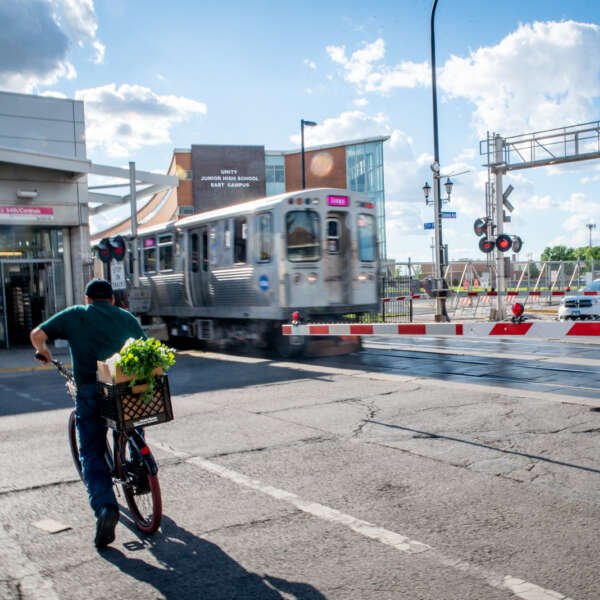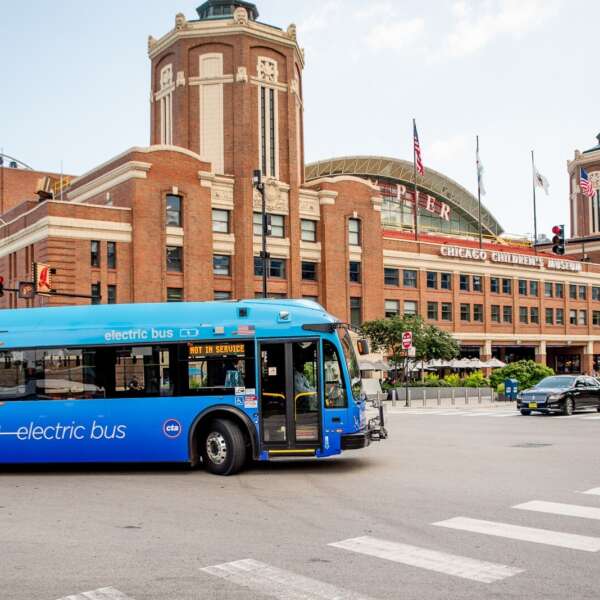CTA, Metra, and Pace outline service adjustments to changing travel patterns
July 11, 2023
July 11, 2023

Transit has been and continues to be a lifeline to many riders, but COVID-19 has also changed when, where, how, and why many residents use transit. Stakeholders have told us that transit needs to be more flexible and adapt to what is needed at this moment to connect more people to opportunity.
In the RTA’s regional transit strategic plan Transit is the Answer, we call for the CTA, Metra, and Pace to adapt bus and rail service to meet the changing needs of riders. This action item will be ongoing throughout recovery from the pandemic as travel patterns continue to shift. The RTA explored how the Service Boards are adapting their operations in April, and only a few months later, they continue to adjust and innovate.
The CTA is currently serving close to 900,000 rides on the average weekday, with about 1 million unique customers per month. This represents 83% of pre-pandemic numbers for unique customers (1.2 million), which shows that while customer recovery has been strong, those customers are riding less frequently than they used to, likely due in large part to hybrid or work-from-home arrangements. To further illustrate this point, Tuesday, Wednesday, and Thursday show the highest ridership. Only 14% of customers are frequent (riding 4-5 days per week), but they account for 46% of all ridership.
While the South and West sides of Chicago showed the most ridership resiliency during the height of the pandemic, due to many riders being essential workers with no transportation alternative, other parts of the city have now rebounded to stronger levels.
While weekend ridership recently jumped to 75% of pre-pandemic rates, the weekday rush or “peak” remains core to CTA’s business. Early pandemic losses during peak commute times have not stuck, and now ridership during peak hours accounts for 40% of all rides. Pre-pandemic, that number was 44%.
When it comes to customer concerns, surveys show that frequent riders are focused on increased frequency, accuracy of bus trackers, and faster and more reliable buses, while infrequent customers are more focused on personal security. One possible explanation for this is that less experienced riders may be more influenced by media coverage on crime, or it may reflect that security concerns cause some people to ride infrequently.
The CTA temporarily adjusted their bus schedules in January 2023 as a result of workforce challenges, and customers surveyed after the changes reported greater satisfaction for bus reliability, wait time, and accuracy of real-time travel information. Improving bus service is essential, as 70% of all Chicagoans live near a bus route but over ½ mile from rail, meaning those riders are likely to take bus to rail. However, bus speeds have gotten slower due to increased congestion, so the CTA is working with roadway agencies and other partners to address bus speed and reliability.
In order to stay informed on the CTA’s progress and changes to service, check out the dashboards and regular updates based on their Meeting the Moment Action Plan.
Metra’s new strategic plan My Metra, Our Future was developed as a result of the pandemic to address new and persistent challenges, such as changes in travel patterns, operating and capital funding needs, and more. Schedules that cater to 9-to-5 travel patterns no longer fit the needs of commuters, thus evolving to “regional rail” service was a key part of each of their strategic goals.
Metra is working on a route restoration study to better understand current travel-demand patterns and incorporate the findings into near term service changes. Building on the results of this study, Metra will create a systemwide network plan that will set standards with new railcars and infrastructure to better serve new travel markets for the decades to come. Finally, the agency will develop an evaluative approach to Transit Oriented Development (TOD) and commuter parking to better respond to the demands of the community.
In June, Metra proposed a plan for 2024 that would simplify their fare structure to improve the rider experience, including changing from the current 10 fare zones to only four zones. The goal is to create a structure that customers can easily understand, that will encourage ridership, and that will simplify onboard fare collection. Learn more.
Pace has addressed several challenges and changes in ridership demands since the start of the pandemic. Sixty-five commuter routes connected to Metra were suspended when COVID began, and while many fixed bus routes were still being used by essential workers, they were most needed in nontraditional hours. As a result, Pace is working on innovating their system through new services and technology such as partnering with transportation network companies Uber and UZURV, expanding their VanGo, On-Demand, and Pulse services, and continuing to partner with TransitApp for their two-year Mobility as a Service (MaaS) pilot project to alert riders, offer seamless trip planning, and more. In partnership with Via, Pace is also piloting Pace Connect, a new late-night ride hailing service near O'Hare Airport and Harvey. For only $2 or less per trip, anyone can take a ride within a designated zone to accommodate first/last mile transportation needs during times when fixed route public transportation isn't readily available.
In June, the CTA, Metra, and Pace presented to the Chicago Metropolitan Agency for Planning’s (CMAP) Transportation Committee, giving updates on ridership trends and how they’re adapting service to meet changing demand. Watch their presentations to learn more.
Subscribe to our Newsletter
Related Articles
 How to use transit to enjoy fall in the Chicago region
How to use transit to enjoy fall in the Chicago region
Instead of mourning another Chicagoland summer come and gone, start creating your plans to make the most of fall. The RTA has curated a list of indoor and ou...
October 17, 2024 How to use transit to explore the Chicago region’s architecture
How to use transit to explore the Chicago region’s architecture
Chicago is one of the world’s great cities for architecture and designed landscapes—and the birthplace of the word “skyscraper.” The region is home to an unm...
September 24, 2024 How to use transit to enjoy Hispanic Heritage Month in the Chicago region
How to use transit to enjoy Hispanic Heritage Month in the Chicago region
Hispanic Heritage Month is celebrated in the United States from September 15-October 15 to recognize the contributions and influence of Hispanic Americans. T...
September 11, 2024 In memoriam: Cartographer Dennis McClendon, ‘Mr. Downtown,’ left his mark on Chicago transit
In memoriam: Cartographer Dennis McClendon, ‘Mr. Downtown,’ left his mark on Chicago transit
The RTA is marking the passing of cartographer and Chicago historian Dennis McClendon, who provided cartographic work to the RTA for more than a decade. McCl...
August 14, 2024 How to navigate the Democratic National Convention using public transportation
How to navigate the Democratic National Convention using public transportation
The Democratic National Convention is coming to Chicago’s United Center and McCormick Place August 19-22, 2024, and with it will come roughly 50,000 visitors...
July 25, 2024 How to use transit to explore museums in the Chicago region
How to use transit to explore museums in the Chicago region
The Chicago region is home to countless accessible cultural and educational amenities including 150 museums across several counties. The most cost-effective ...
July 10, 2024